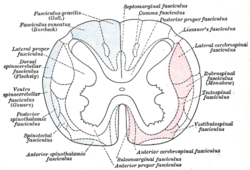Tectospinal tract
| Tectospinal tract | |
|---|---|
 Diagram showing possible connection of long descending fibers from higher centers with the motor cells of the ventral column through association fibers. ("Tectospinal fasciculus" labeled at center right.) | |
 Diagram of the principal fasciculi of the spinal cord. ("Tectospinal fasciculus" labeled at center right, in red.) | |
| Details | |
| Identifiers | |
| Latin | tractus tectospinalis |
| MeSH | D065844 |
| NeuroLex ID | birnlex_759 |
| TA98 | A14.1.02.211 A14.1.04.112 |
| TA2 | 6119 |
| FMA | 72620 |
| Anatomical terminology | |
In humans, the tectospinal tract (or colliculospinal tract) is a decussating extrapyramidal tract that coordinates head/neck and eye movements.[1]: 233 It arises from the superior colliculus of the mesencephalic (midbrain) tectum, and projects to the cervical and upper thoracic spinal cord levels.[1]: 113 It mediates reflex turning of the head and upper trunk in the direction of startling sensory stimuli (visual, auditory, or skin).[1]: 109
It arises from the deep layers of the superior colliculus. It decussates within the posterior part of mesencephalic tegmentum[1]: 233 at the level of the red nucleus.[1]: 241 It descends through the medulla oblongata near the midline with the medial longitudinal fasciculus.[1]: 100 In the spinal cord, it descends in the anterior funiculus.[1]: 233 It terminates by synapsing with interneurons[1]: 241 of the intermediate zone and anterior grey column.[1]: 233
